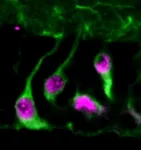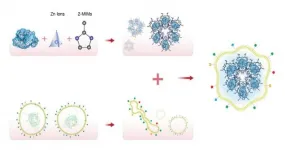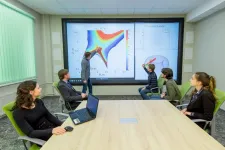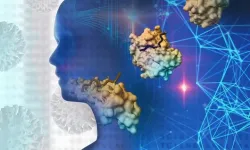(Press-News.org) There's a reason that ideas--even erroneous ones--catch fire on social media or in popular culture: groupthink.
New research co-authored by Berkeley Haas Asst. Prof. Douglas Guilbeault shows that large groups of people all tend to think alike, and also illustrates how easily people's opinions can be swayed by social media--even by artificial users known as bots.
In a series of experiments, published in the journal Nature Communications, Guilbeault and co-authors Damon Centola of the University of Pennsylvania and Andrea Baronchelli of City University London created an online game that asked numerous people to identify what they saw in Rorschach inkblots.
"In small groups, there was a ton of variation in how people described the shapes," says Guilbeault, who studies collective intelligence and creativity, categorization, and social media policy. "As you increase the size of the group, however, rather than creating unpredictability, you could actually increase your ability to predict the categories."
It's not that there was a lack of ideas in the large groups--in fact, the larger the group, the more categories for blots were initially proposed. However, some categories just seemed to appeal to more people than others. As more people communicated with each other, the slightly more popular categories won out. The large groups consistently settled on just a handful of categories, including "crab," "bunny," "frog," and "couch"--even when the blots themselves varied.
"When you're in a small group, it's more likely for unique perspectives to end up taking off and getting adopted," Guilbeault explains. "Whereas in large groups, you consistently see 'crab' win out because multiple people are introducing it, and you get a cascade."
When you're in a small group, it's more likely for unique perspectives to end up taking off and getting adopted.
Interestingly, however, he and his colleagues were able to manipulate the choices people made by introducing "bots" with an agenda into the system. These automatic participants continually implanted the idea that the blots looked like a sumo wrestler, an otherwise unpopular category. Sure enough, when a critical mass of bots pushed the idea, human participants also started adopting it.
Once more than a third (37%) of participants advocated for sumo wrestler, they found, the group was likely to adopt it over other categories. What's more, when researchers afterwards showed those participants the image that was most likely deemed a crab by other groups, they were much more likely now to call it sumo as well. "We showed people the crabbiest crab, and now people said it looked like a wrestler. No one described it as looking like a sumo wrestler, let alone like a person, in the large groups without bots," Guilbeault says.
The same phenomenon happens on social media, says Guilbeault, who has previously researched the influence of Twitter bots, including their role in the 2016 election. By pushing an idea over and over, both real and automated users are able to sway the majority to use their terms. "In some sense, Trump's presidency was a war over categories," Guilbeault says. "Ten years ago, no one was talking about 'fake news,' and now everyone is trying to categorize whether news media is fake or not."
In some sense, Trump's presidency was a war over categories. Ten years ago, no one was talking about 'fake news,' and now everyone is trying to categorize whether news media is fake or not.
For that reason, he says, content moderation by social media platforms that relies on identifying the difference between real and fake news may be actually be doing more harm than good by subtly validating categories they are criticizing. "Just by trying to put out the fire in the moment, they are sending the message that this is the right category," he says, "while a different category system may allow for more nuance and subtlety."
A better approach may be to focus on getting rid of the bots spreading the categories in the first place--or to create more accurate categories that are also appealing enough to spread, he says. Take the naming of the more contagious coronavirus variants that have appeared, for example. Small groups of scientists devised highly technical names, such as 501.Y2 and B.1.1.7, to describe the virus strains. Meanwhile, the public has adopted easier-to-remember geographical names such as the South Africa and UK variants, respectively.
The problem is that those names risk stigmatizing regions and misrepresenting how widespread these variants really are. A scientific body could test new naming systems that might be both more accurate and more successful in getting adopted.
"You could do market research in a networked focus group," says Guilbeault, discovering or creating the social media equivalent of 'crab' in order to spread more benign ideas. Those strategies might ultimately succeed better than using flags or warnings in changing the way people communicate, he says, leading to a more civil public discourse overall.
INFORMATION:
Just as beneficial microbes in the human gut can be affected by antibiotics, diet interventions and other disturbances, the microbiomes of other animals can also be upset. In a rare study published this week, Andrea Jani, a researcher with the University of Hawai'i at Mānoa School of Ocean and Earth Science and Technology (SOEST), determined the skin microbiome of an endangered frog was altered when the frogs were infected by a specific fungus, and it didn't recover to its initial state even when the frog was cured of the infection.
All animals host symbiotic microbes--many ...
WASHINGTON--Chinese people are more likely to face high blood pressure and other health risks as a result of higher body mass index (BMI) and waist circumference than people from other racial and ethnic groups, according to a new study published in the Endocrine Society's END ...
SINGAPORE, 10 February 2021 - Researchers studying an enzyme in fruit fly larvae have found that it plays an important role in waking up brain stem cells from their dormant 'quiescent' state, enabling them to proliferate and generate new neurons. Published in the journal EMBO Reports, the study by Duke-NUS Medical School, Singapore, could help clarify how some neurodevelopmental disorders such as autism and microcephaly occur.
Quiescent neural stem cells in the fruit fly larval brainPr-set7 is an enzyme involved in maintaining genome stability, DNA repair and cell cycle regulation, as well as ...
Modern telecommunication systems rely on satellites to relay signals across the globe quickly and reliably, enabling users to send messages across the world in an instant, watch live television, or - more recently - hold conference calls with global partners right from the kitchen table!
Communications satellites use high-frequency radio waves to transmit data, with antennas acting as a two-way interface, converting electric current provided by the transmitter into radio waves, and vice versa when paired with a receiver. Antennas are therefore vital pieces of equipment, without which satellites and ground receivers would be practically useless. However, despite advances in modern satellite design and performance, antenna technology remains a limiting factor for ...
With the advent of 5G communication technology and its integration with AI, we are looking at the dawn of a new era in which people, machines, objects, and devices are connected like never before. This smart era will be characterized by smart facilities and services such as self-driving cars, smart UAVs, and intelligent healthcare. This will be the aftermath of a technological revolution.
But the flip side of such technological revolution is that AI itself can be used to attack or threaten the security of 5G-enabled systems which, in turn, can greatly compromise their reliability. It is, therefore, imperative to investigate such potential security threats and explore countermeasures before a smart world is realized.
In a recent study published ...
Researchers at the University of Virginia School of Medicine have shed light on what causes herpes simplex virus to flare up, explaining how stress, illness and even sunburn can trigger unwanted outbreaks.
The discovery could lead to new ways to prevent cold sores and herpes-related eye disease from reoccurring, the researchers report.
"Herpes simplex recurrence has long been associated with stress, fever and sunburn," said researcher Anna R. Cliffe, PhD, of UVA's Department of Microbiology, Immunology and Cancer Biology. "This study sheds light on how all these triggers can lead to herpes simplex-associated disease."
About Herpes Simplex ...
Joe Biden is the new president of the United States, although half of the country's Republicans believe he stole the election. A lot of people believe conspiracy theories on the other side of the Atlantic. But they aren't only found there.
Conspiracy theories are not exclusive to people who storm the U.S. Capitol.
"Everyone believes at least one conspiracy theory," says Asbjørn Dyrendal, a professor in NTNU's Department of Philosophy and Religious Studies who specializes in conspiracy theories.
The more conspiracy theories you bring up, the more people answer yes to one of them.
That fact leads ...
Loading a cancer immunotherapy drug onto a metal organic framework improves both its delivery and its sustained release for treating leukemia. Furthermore, coating the drug-loaded framework with a cancer cell membrane improves targeted delivery to solid tumors. These findings could lead to safer and more reliable cancer immunotherapies.
"We believe our findings are quite significant because they show that the undesirable side effects of immunotherapy can be modulated by choosing the right delivery vehicle," says KAUST chemist Niveen Khashab. "They also show that targeted delivery can be realistically established through proper surface functionalization." ...
The energy of the future lies in the area of the controlled thermonuclear fusion. The scientific group from Peter the Great St.Petersburg Polytechnic University (SPbPU), headed by Professor Vladimir Rozhansky, is directly involved in the establishment of the world's largest experimental thermonuclear reactor ITER. Researchers discovered new effects, which affect the energy flow in the reactor. The theoretical predictions were confirmed by the experiments on two tokamaks. The research results were published in the scientific journal "Plasma Physics and Controlled Fusion".
The scientific group of Polytechnic University is engaged in modeling of the edge plasma. The researchers aim to identify how and ...
In the early days of the COVID-19 pandemic, it was established that SARS-CoV-2 infects cells by binding to the human protein ACE2, which plays a role in regulating blood pressure. But ACE2 is almost absent in human lung cells, so how can the lungs be one of the most affected organs in COVID-19? This gave researchers a hint that ACE2 might be more than just a blood pressure regulator, and might not be the only player in the SARS-CoV-2 infection mechanism.
EMBL's Gibson team, in collaboration with Lucía Chemes at Universidad Nacional de San Martín in Buenos Aires and ...







